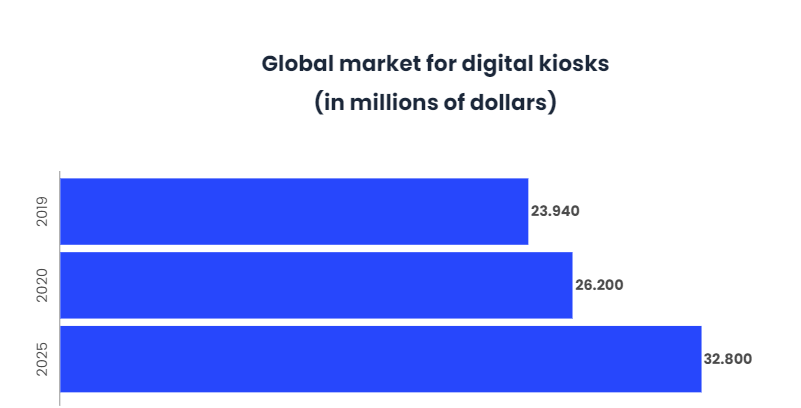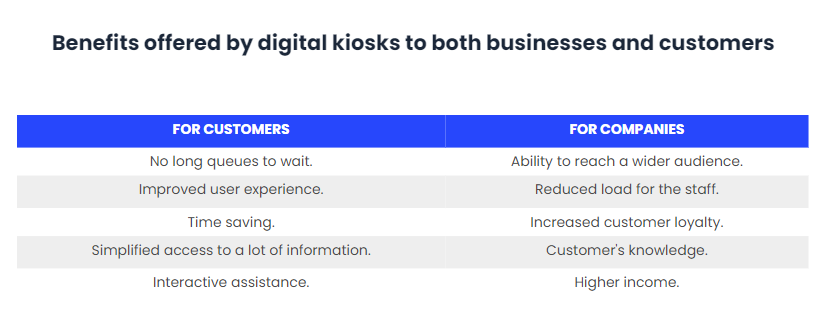Digital Kiosks: transforming customer interaction

The world is spinning at a very fast pace, and customers increasingly prefer quick interactions with them so they can move on to other tasks without taking up too much time. The solution to this demand is in digital kiosks, self-service terminals that allow users to interact with digital content and information through an intuitive interface. These kiosks speed up ordering, shopping and other self-service tasks. They help customers quickly find the products, services or information they need, creating more personalised experiences and saving them a lot of time.
They also help banks, restaurants, smart cities, transportation providers, hospitals and shops to automate certain tasks. This creates faster service and frees up employees to focus on creating higher value experiences.
A growing market
The global market for interactive digital kiosks was valued at 23.94 billion dollars in 2019, is expected to reach 26.2 billion dollars in 2020 and to reach 32.8 billion dollars in 2025.

The retail industry will benefit most from interactive digital kiosks, where the deployment of information and promotion has become one of the main forms of customer attraction. Self-directed bill payment, digital signage and final product purchase are essential applications for retailers to keep their costs down.
On the other hand, this growth in the digital kiosk market is due to the following factors:
- Improved, customer-centric shopping experience for immediate self-service
- Lower investment than traditional assets and reduced employee costs.
- Innovations in Artificial Intelligence technology, touch screen and glass technology
- Increased demand for these kiosks for retail and financial services worldwide.
- Improvements in the interactive platform.
- Development of digital kiosks by market players.
In this sense, the growing adoption of Cloud computing in contactless payment solutions is also likely to make the market for digital kiosks gain traction.
Many companies are already implementing Artificial Intelligence and Cloud computing in such terminals to further reduce costs. Many shops in Spain are using interactive machines to avoid queues, using solutions such as RFID, QR codes and Smartphone transactions.
Functions that digital kiosks can offer
The digital kiosks are designed with different functionalities to provide information and services. They can include sensors, cameras and microphones that allow companies or Smart Cities to monitor kiosk operations, expedite automatic payment, collect environmental data and provide accessibility to users.
Because they are highly customisable, digital kiosks can act as remote representatives of companies in various sectors, replacing a range of services that are traditionally performed manually. Digital kiosks can perform the following functions:
- Make payments (by card or cash).
- Providing helpful information.
- Real-time alerts.
- Personalised offers.
- Buy products.
- Consult the stock of a shop.
- Recommend a product.
- Printing, for example, of maps or tickets.
- Wayfinding (orientation services, finding a street or a place).
- Digital advertising.
- Providing access to the Internet.
- Emergency calls.
These machines are incredibly useful for customers and beneficial for companies, especially when they are located in places with a lot of human traffic, such as shopping centres, train stations or airports.
Benefits offered by digital kiosks
Digital kiosk terminals are gaining momentum because of a number of advantages they offer to both users and businesses.

Digital kiosks can be combined with customisation tools so that potential customers can find the best product to meet their needs. They are terminals where a large amount of information, both about a company and a product, can be put within reach of both staff and customers. For example, in retail, this allows them to explore and compare features and benefits, depending on their tastes and familiarity with the brand. Some may approach kiosks with a product in mind and want to see detailed product-specific information, while other customers may want to browse and find the products that best suit their needs.
These terminals also help companies save money by reducing business costs. This allows employees to focus on tasks that are more essential, also reinforcing their personal satisfaction. As 24-hour terminals, digital kiosks offer a consistent, high-quality user experience, improving business efficiency.
In addition, these terminals are perfect for collecting data on customer behaviour, which will improve the shopping experience, advertise more effectively, provide better services and increase sales. And it is precisely because of the increase in sales that more and more companies are using digital kiosks.
Interactive kiosks are very effective marketing tools that can influence customers to buy certain products through promotions, discounts and other attractive offers, which would increase sales. This would also result in a rapid return on investment.
For customers, digital kiosks can keep them informed in real time, which gives them instant satisfaction with the technology, as they can solve their needs themselves by avoiding long queues and waiting times.
Use cases in all industries
Digital kiosks greatly enhance the customer experience, so companies in almost every industry can take advantage of the benefits these solutions offer. These are the main sectors that currently use or actively integrate digital kiosks into their processes:
Health care
Digital kiosks are very popular in hospitals and medical centres because they optimise the interaction between patients and medical staff in a cost-effective way. Through these terminals, patients can find the necessary information about services or book an appointment, which greatly relieves the workload of administrative and medical staff.
In addition, these kiosks can assist with orientation in the buildings by providing the floor plan (with the ability to print it out).
Banking sector
Self-service systems are widely used in financial institutions, offering customers the possibility to carry out their financial transactions, obtain printouts and request a consultation with a specialist.
With the arrival of the Covid-19, many financial institutions have made use of these terminals in order to create an additional revenue stream during the crisis. The kiosk can offer prepaid cards, ready-to-use SIM cards, receipt printing, payment terminal to process direct payments, even discount coupons for apps, video games, music and purchases.
Some banks are taking traditional ATMs to the next level with interactive kiosks offering live consultation and other services, such as those mentioned above. This allows banks to consolidate their presence or expand without having to build a physical branch.
Transport sector
Digital kiosk solutions are common in transportation centres such as airports, subways, buses and train stations. The central option they offer for this area is the automation of ticket sales, baggage check-in, access to maps or viewing of departure and arrival times, and check-in procedures, which means that a passenger can book a ticket, choose a seat, pay for it and complete the boarding procedure without any assistance. This helps to manage foot traffic and reduce waiting times.
On the other hand, as airports, subways, train stations, etc. are busy areas, digital kiosks are also an excellent way to offer digital advertising. A ticketing kiosk in a train or metro station presents a good opportunity to cross-sell and promote events to be held in the area or to encourage visits to places of interest.
Digital kiosks in hotels
In hotels, digital information kiosks are a great help in welcoming visitors from other cities and countries, and making their stay comfortable. They can offer:
- Quick and easy check-in and check-out.
- Accurate information on the hotel and the city’s infrastructure.
- Online reservation of services, e.g. car rental.
Since the main objective of hotels is customer satisfaction, digital kiosks are the best tool to achieve it.
Retail sector
Digital kiosks enable retailers to create seamless multi-channel customer experiences. These terminals located in shopping centres, shops, etc. serve as a channel for sales, communication and information exchange between sellers and buyers. Their main functions are:
- Informing consumers about special offers and discounts in shops.
- Filter the shops in the shopping centre according to the user’s criteria (e.g. clothing, food, children’s items)
- Viewing and printing the map of the shopping centre.
- Collect customer comments.
- Self-payment to reduce waiting times.
- When equipped with Artificial Intelligence (AI) based product identifiers, the kiosks also help to confirm that the items placed in the basket match the PLU code entered by the customer, this makes the whole process much faster.
Retailers can now offer a much more valuable personal service through a digital platform.
Smart cities
Smart Cities provide citizens and tourists with outdoor digital kiosks to announce events, tourist sites, restaurants, shops and real-time information about the area. These kiosks typically offer Wi-Fi, emergency calls, directions and a built-in printer for users to print tickets or maps.
In addition, these kiosks make public information related to the Town Hall, government or authorities available to all residents, including those who do not have a computer or Internet access. Current news, urban information, instructions on administrative procedures in the form of computer graphics or video presentations: this type of content can improve the image of the city government and enhance its communication with the people.
Education
Digital kiosks are also increasingly present in the education sector, and are starting to play an important role in schools. As well as providing access to a lot of information, they are also a way for schools to communicate with students, teachers and visitors.
The functions that can be carried out at a digital kiosk by students, teachers and parents are already part of the daily life of educational institutions. Since young people are already used to dealing with new technologies, it is almost natural to interact with multimedia kiosks.
In this sense, digital kiosks also end up creating a relaxed atmosphere in educational institutions, providing access to useful information, interactive classes, interactive games, news, events, courses, among other communications. But there are other functionalities such as security notifications, the possibility of buying school material, consulting examination notes and timetables, reserving a library book, visualizing cafeteria menus, orientation maps, printing or scanning, which make the efficiency of the educational centre increase.
Conclusions
Digital kiosks help reduce the operational costs of having an employee attend, while increasing user satisfaction for immediate service.
In addition, with the advent of the Covid-19 and health restrictions, there is a demand for less face-to-face interaction and more self-service, and despite high deployment costs, the investment can be beneficial in the long term through automation. However, a more pessimistic view suggests that due to the crisis, few companies can afford to pay for, install and maintain such terminals.
The retail industry is transforming the way consumers relate to brands, and through kiosks, companies can offer products specifically targeted at certain consumer segments.


